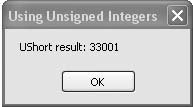Recipe 6.3. Using Unsigned Integers
ProblemYou want to work with nonnegative integers while minimizing the memory requirements of variables in your code. SolutionUse the smallest unsigned integer variable types that will hold the desired range of nonnegative values. DiscussionAs mentioned in the previous recipe, the unsigned integer variable types provide many new options for working with nonnegative integers in Visual Basic 2005. The following code provides a specific example to help clarify the concept: Dim testUShort As UShort Do Until (testUShort > CUShort(33000)) testUShort += CUShort(1) Loop MsgBox("UShort result: " & testUShort.ToString()) The standard Visual Basic Short variable type holds signed integers in the range -32,768 to +32,767 and uses only two bytes of memory. If the previous code used signed integers, an exception would be generated during the looping because values up to 33,001 are not allowed. The unsigned testUShort integer stores values up to 65,535, so the program runs successfully, and the variable still requires only two bytes of memory. Figure 6-3 shows a two-byte unsigned variable displaying a number too big for a standard signed two-byte integer. Figure 6-3. Unsigned integer variables can hold bigger numbers than signed integers, in the same amount of memory See AlsoSearch for "UInteger" in Visual Studio Help for more information. |
EAN: 2147483647
Pages: 400
- ERP System Acquisition: A Process Model and Results From an Austrian Survey
- The Second Wave ERP Market: An Australian Viewpoint
- The Effects of an Enterprise Resource Planning System (ERP) Implementation on Job Characteristics – A Study using the Hackman and Oldham Job Characteristics Model
- A Hybrid Clustering Technique to Improve Patient Data Quality
- Relevance and Micro-Relevance for the Professional as Determinants of IT-Diffusion and IT-Use in Healthcare